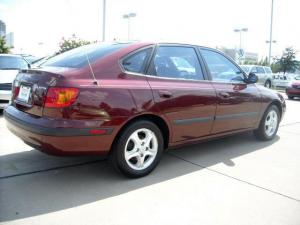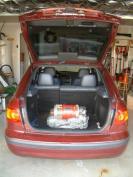| Owner | A F | ||||||||
|---|---|---|---|---|---|---|---|---|---|
| Location | Grand Prairie, Texas United States map | ||||||||
| Web/Email | WebPage | ||||||||
| Vehicle | 2002 Hyundai Elantra GT 5-door hatchback with a Prius-like rear profile | ||||||||
| Motor | Netgain WarP ImPulse 9 Series Wound DC Quite a versatile and powerful motor. Recommended by "Build Your Own Electric Vehicle", second edition (2008), by Seth Leitman and Bob Brant. | ||||||||
| Drivetrain | Will use the existing 5-speed manual transmission. | ||||||||
| Controller | Logisystems 156AFX This controller can take 144-156 volts at up to 750 amps. This is probably overkill for my car. I could have gone with the 120-144 volt 550 amp Logisystems controller, but decided to go with the higher numbers. This way (I hope) the controller will be under less stress, operating at the lower end of its range. | ||||||||
| Batteries | 12 Trojan T-1275, 12.00 Volt, Lead-Acid, Flooded I decided to use lead-acid for my first battery pack, due to lower cost and to get more experience with the system. When that pack dies I may get something more expensive. I chose the Trojan T-1275 for several reasons: a) Trojan has a good track record in EV applications; b) I need 12 volt batteries to get my desired voltage without far exceeding 1000 lbs of lead; and c) according to my calculations, this battery should provide the range I want, at a battery cost of about $0.04 to $0.05 per mile (that is, just the cost of replacing the battery pack factored over the expected miles). | ||||||||
| System Voltage | 144 Volts | ||||||||
| Charger | NetGain Controls 3000W HF/PFC NetGain Controls, Inc. 3000W HF/PFC charger | ||||||||
| Heater | Not sure, but for convenience I would prefer to use the existing stock tubing and systems, and install a small electric water heater in the engine bay, rather than replacing the heater core with a ceramic heating element. This may be too expensive though. | ||||||||
| DC/DC Converter | Iota 501-DLS-110-55-K 108VDC - 190VDC 55A DC/DC Converter Kit I paired this with a small 12V lawn-mower- tractor battery for the 12VDC system. | ||||||||
| Instrumentation | I hope to re-use as much of the stock instrumentation as possible, but this may be more work than it's worth. The existing tachometer and speedometer work; I bought a speed sensor from KTA- EV that ties into the tachometer. I'd like to use the fuel gauge as a SOC meter; and I may replace the temperature gauge with an ammeter. I also need warning lights for motor over temperature and motor brush wear. I may re-use existing lights, such as the "Check Engine" light, for things like this. I also have the PakTrakr battery monitoring system, which is nice. | ||||||||
| Top Speed | Goal: highway speeds Have not yet gotten it onto the highway. | ||||||||
| Acceleration | Goal: it should feel similar to the original Currently, accelerates sluggishly sometimes and at other times it jumps. I think I still have to learn what gears to use, and also I need to adjust the controller. | ||||||||
| Range | Goal: at least 40 miles Just got it on the road. Have not yet tested the range. | ||||||||
| Watt Hours/Mile | Not yet determined | ||||||||
| EV Miles |
| ||||||||
| Seating Capacity | 5 adults | ||||||||
| Curb Weight | 0 Stock weight is 2635 lbs according to online specs. It is just a tad bit more than a 2002 Civic 4 door EX, the other car I was looking at, yet it feels much larger inside and outside. Problem: I had it weighed on 2008-10-11 and the scale said it weighs 3100 lbs, as-is, stock. I highly doubt the scale is accurate; it was a CAT truck scale, and I think they overcompensate on the weight to avoid trucks getting fined for being overweight. Anyone know a better way to weigh cars? | ||||||||
| Tires | Stock. When these wear out, I'll probably get low rolling resistance tires, but I don't plan to change the rims/hubs. | ||||||||
| Conversion Time | I have been planning and ordering parts since October 2008. Due to my job situation, I didn't start the conversion until October 2009. I finally got it on the road as of August 2010. I did not track the hours spent. | ||||||||
| Conversion Cost | I have not run the numbers recently, but budget was $7K for conversion, plus about $2.5K for batteries. The car itself cost me about $4K. Total: about $13-14K. | ||||||||
| Additional Features | Has power brakes using the kit from evsource.com. Hoping to restore the A/C and power steering. For now, I'm saving the existing power steering pump and A/C compressor, and plan to run at least the A/C off a pulley on the tail end of the motor. There are some tradeoffs to doing it this way, but should be good enough. If it doesn't work very well I'll have to replace with all-electric systems. | ||||||||
| For my first conversion, I started by researching highly rated used cars. To my surprise, the 2001-2006 Hyundai Elantra was picked as the "used car best bet" by Edmunds.com ( WebPage ) in the Compact Sedan category, for its reliability and overall value. I was expecting to see a Civic in that slot. However, as I have researched it more, it seems an ideal candidate for conversion. I wanted something clean and relatively recent, as I hope to use it for many years to come and I don't want to bother with reconditioning the vehicle. (Converting it is already a big enough commitment!) The Elantra GT is sporty, yet affordable enough that I could get one with leather, power everything, moonroof, and still in great condition. It is a five-door hatchback, with a profile that looks almost like the Prius in the back. This profile seems to be more aerodynamic, with a drag coefficient of 0.33, probably contributing to its good gas mileage. This profile also gives lots of trunk room for batteries and still leaves storage room for other things. The car is light, almost as light as the Civic I was looking at, yet much more roomy inside. The rolling resistance seems low. Overall it seems to be almost made for this conversion, as long as the reliability holds up as the reviews have said. Many thanks to North Texas Electric Auto Association (NTEAA; WebPage ) for all the help and tips. | |||||||||
Copyright © 1997-2025 by Mike Chancey







